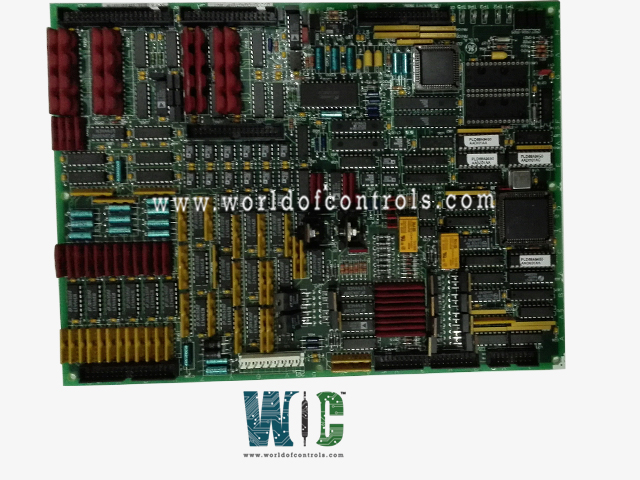SPECIFICATIONS
Part No.: DS200TCQAG1BED
Manufacturer: General Electric
Country of Manufacture: United States of America (USA)
Technology: Surface-mount
Temperature Operating: -30 to 65oC
Product Type: Optional Power Distribution Board
Availability: In Stock
Series: Mark V
Functional Description
DS200TCQAG1BED is an optional power distribution board developed by GE. It is a part of Mark V control system. The Analog IO Board is an integral component used to scale and condition a variety of analog signals received from terminal boards mounted on the I/O cores R1, R2, and R3. The primary function of the board is to scale and condition various analog inputs and outputs to ensure accurate and reliable signal processing. The board integrates multiple types of signals, including displacement, temperature, pressure, vibration, and electrical signals, providing a centralized platform for signal conditioning. By interfacing with other boards, such as the STCA and TCQC, via specific connectors, the TCQA board plays a crucial role in the broader signal processing and control architecture.
Signal Types and Handling
- LVDT Inputs (Linear Variable Differential Transformer): LVDT inputs are used to measure linear displacement. The board conditions these signals to ensure accurate readings.
- Servo Valve Outputs: These signals control the position of servo valves. The board processes these outputs for precise control.
- Thermocouple Inputs: Thermocouples measure temperature. Scales and conditions these inputs to provide accurate temperature readings.
- 4-20 mA Inputs and Outputs: This standard industrial signal range is used for various sensors and actuators. The board conditions these signals, including important inputs like fuel flow pressure and compressor stall-detect signals.
- Vibration Inputs: These signals monitor vibrations in machinery. The board ensures these inputs are correctly scaled and conditioned for monitoring and analysis.
- Relay Driver Outputs: The board processes outputs that drive relay circuits, which control high-power devices.
- Pulse Inputs: These inputs count events or measure the speed of rotating equipment. The board conditions these signals for accurate counting and timing.
- Voltage Inputs: Various voltage levels are conditioned on the board to ensure they are within the required range for further processing.
- Generator and Line Signals: Signals related to generator output and electrical line conditions are exchanged with the board via the JE connector. The TCQA board ensures these signals are accurately scaled and conditioned.
Signal Exchange and Connectivity
- STCA Board via 3PL Connector: Some conditioned signals from the board are written to the STCA board using the 3PL connector. This allows for further processing or integration into the system's control and monitoring framework.
- TCQC Board via JE Connector: The generator and line signals are exchanged between the TCQA and TCQC boards through the JE connector, facilitating comprehensive signal management and conditioning within the system.
Hardware Configuration
- The board includes several hardware jumpers that need to be configured to match the desired operational settings.
- Jumpers J1 and J2 are specifically used to select the mA output circuits. For setting the current range of the mA outputs, jumpers J5 and J6 are used, allowing the configuration of either a 20 mA maximum or a 200 mA maximum output.
- Jumper J7 is designated for the RS232 port, which is utilized for conducting card tests, ensuring the board is functioning correctly. Additionally, jumper J8 is used to enable an oscillator if required by the application.
Software Configuration
- In addition to hardware configuration, the board requires specific software configuration constants to be entered for various inputs and outputs. These include constants for thermocouples, which need to be set for accurate temperature readings, and for pulse rates, ensuring correct counting and processing of pulse inputs.
- Vibration monitoring settings must also be configured to accurately measure and analyze vibrations.
- For linear displacement measurements, configuration constants for LVDT positions must be input.
- For the standard industrial 4-20 mA inputs and outputs, appropriate scaling and conditioning constants need to be entered into the I/O Configuration software. This software configuration ensures that the board accurately processes all types of signals it handles.
The WOC team is always available to help you with your Mark V requirements. For more information, please contact WOC.
Frequently Asked Questions
What is DS200TCQAG1BED?
It is an optional power distribution board developed by GE under the Mark V series.
What types of signals does the board handle?
The board handles a wide range of signals, including LVDT inputs, servo valve outputs, thermocouple inputs, 4-20 mA inputs and outputs, vibration inputs, relay driver outputs, pulse inputs, voltage inputs, and generator and line signals.
How are LVDT inputs processed by the board?
LVDT inputs, which measure linear displacement, are conditioned by the board to ensure accurate readings.
What is the role of the board in handling 4-20 mA signals?
The board scales and conditions 4-20 mA signals, which are commonly used for various industrial sensors and actuators. This includes important inputs such as fuel flow pressure and compressor stall-detect signals.
